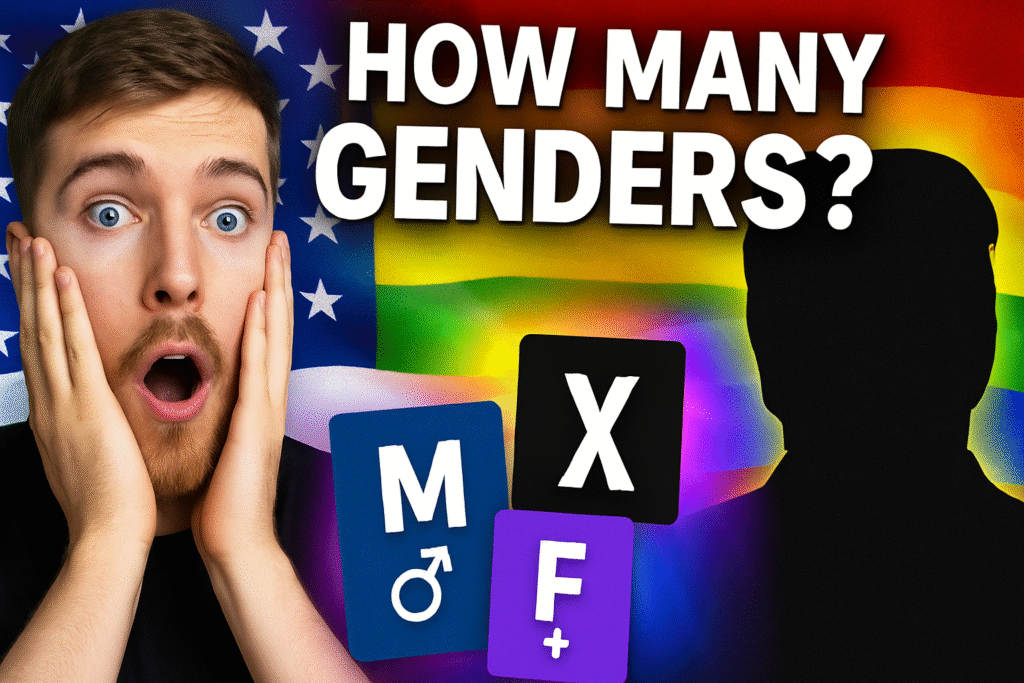When most people think of gender, they often think of just two: male and female. But in the U.S. — and around the world — the understanding of gender has evolved 🌍. Today, gender is no longer seen as only a biological fact, but also as part of someone’s identity, expression, and lived experience 💬🧠.
So, how many genders are recognized in America today? The answer is more complex than a number — but let’s explore it clearly and respectfully. 🧭
🧬 First, Let’s Break Down: What Is Gender?
Gender is different from sex.
- Sex refers to physical and biological traits (like chromosomes, hormones, and anatomy) 🧪.
- Gender is more about identity — how someone feels inside and how they choose to express themselves 💃🧍♂️.
Gender exists on a spectrum, which means people may not fit neatly into just “man” or “woman.” 🎨
📜 Legally Recognized Genders in the U.S.
Across the United States, the recognition of gender identity varies depending on the state, but most states now recognize at least three gender options on official documents like driver’s licenses or birth certificates:
- Male (M) ♂️
- Female (F) ♀️
- Non-Binary (X) ❌
The “X” marker is used by people who do not identify strictly as male or female. This can include identities like non-binary, genderqueer, agender, and others.
As of 2025, more than 22 states and federal agencies like the U.S. State Department (for passports) allow an “X” gender option. ✅🛂
🌈 Other Gender Identities Commonly Recognized Socially
Socially — in schools, workplaces, and communities — many Americans recognize and respect a broader list of gender identities. Here are just a few:
- Non-binary 🧍♀️🧍 — not exclusively male or female
- Genderqueer — a mix of genders or rejecting gender labels
- Genderfluid — gender identity can shift over time
- Agender — no gender identity at all
- Bigender — identifying as two genders
- Two-Spirit — a traditional identity among many Indigenous North American cultures
- Demiboy / Demigirl — partly identifying as a man or woman
- Transgender (trans) — identifying with a gender different from one’s assigned sex at birth
- Cisgender — identifying with the gender assigned at birth
And there are others — because gender is personal, cultural, and evolving. 🌀
🏛️ What Does the U.S. Government Say?
In 2021, the U.S. State Department announced that U.S. passports could include the gender marker “X” for non-binary and intersex individuals. This was a huge step toward inclusion at the federal level. 🆔📘
By 2022, the White House openly supported recognizing and protecting transgender and non-binary Americans, and federal agencies began updating systems to be more inclusive of different gender identities.
This means more spaces — from healthcare to schools to job applications — are beginning to offer more than just two gender choices. 📋💼
🔍 Why Does It Matter?
For many people, being able to legally and socially identify with their true gender is life-changing. It allows them to:
- Be seen and respected for who they are 👤
- Feel safer and more included 💬
- Access healthcare and services that fit their needs 🏥
Mislabeling someone’s gender, even by accident, can feel deeply invalidating. That’s why recognizing a range of genders is not about confusion — it’s about respect and human dignity. 🫂
❓Is There a Set Number of Genders?
Not really. While legal systems may list 2 or 3 options, gender itself is not limited by a fixed number.
Different cultures have recognized multiple genders for centuries:
- Hijra in South Asia 🇮🇳
- Fa’afafine in Samoa 🇼🇸
- Two-Spirit in Indigenous tribes across North America 🪶
- Kathoey in Thailand 🇹🇭
These gender identities are respected and often deeply rooted in history and spirituality. 🕊️
So, in the U.S., the number of genders recognized socially and culturally continues to grow as understanding expands.
🧠 Final Thoughts: Respect Over Counting
So, can we say exactly how many genders exist in America today? ❌ Not with a fixed number.
✔️ Legally: Many systems now recognize 3 options (M, F, X)
✔️ Socially: Dozens of identities are embraced and respected
✔️ Culturally: Gender diversity is not new — it’s just gaining more visibility
At the end of the day, the goal isn’t to memorize a list of genders — it’s to listen, learn, and respect how people describe their own identity. 🌈❤️
Because everyone deserves to live as their true self — no matter how they identify. 🌟


